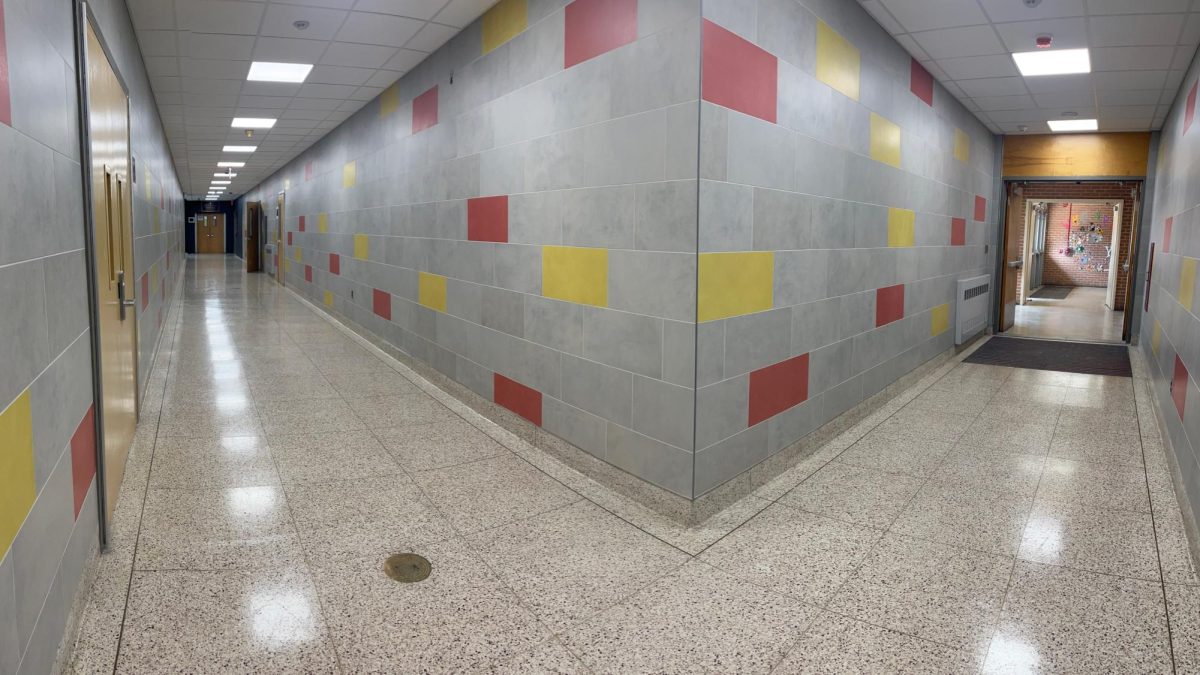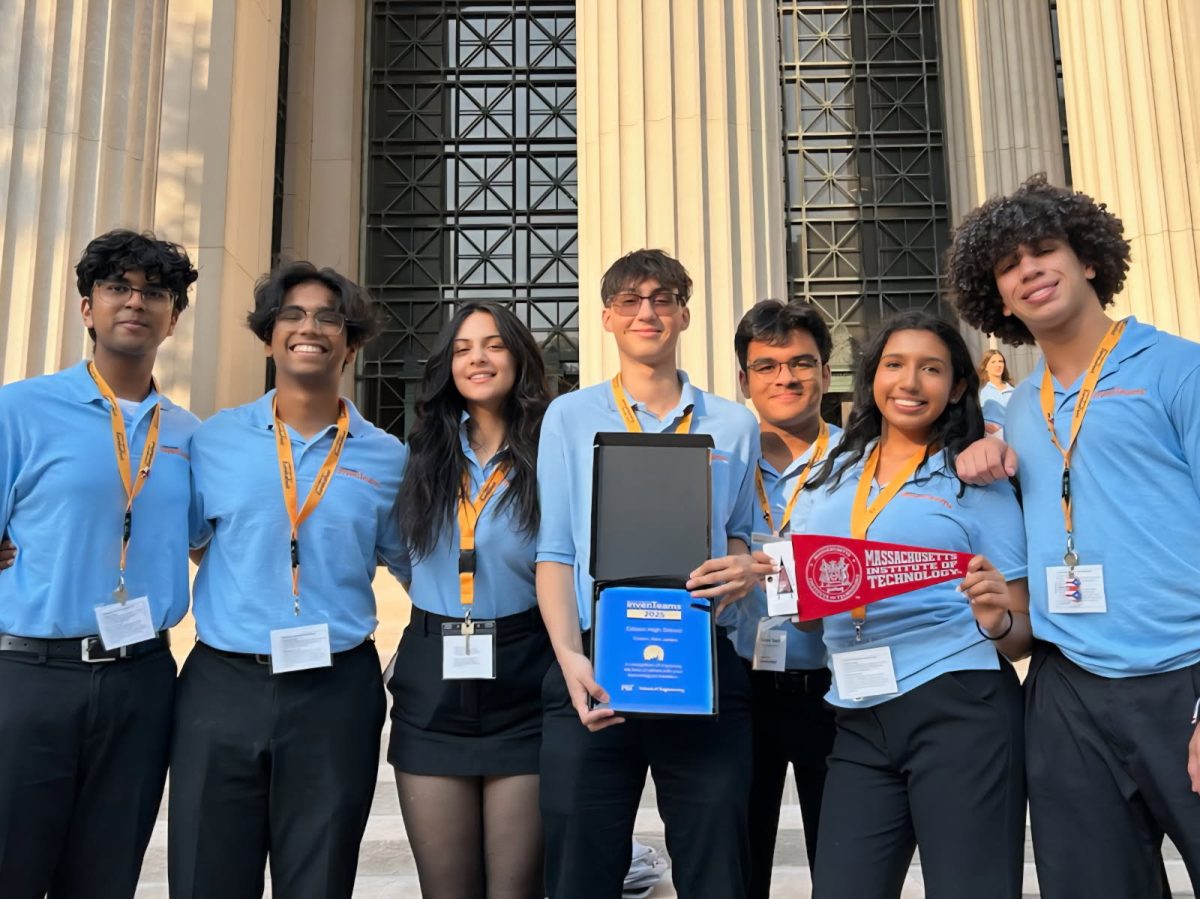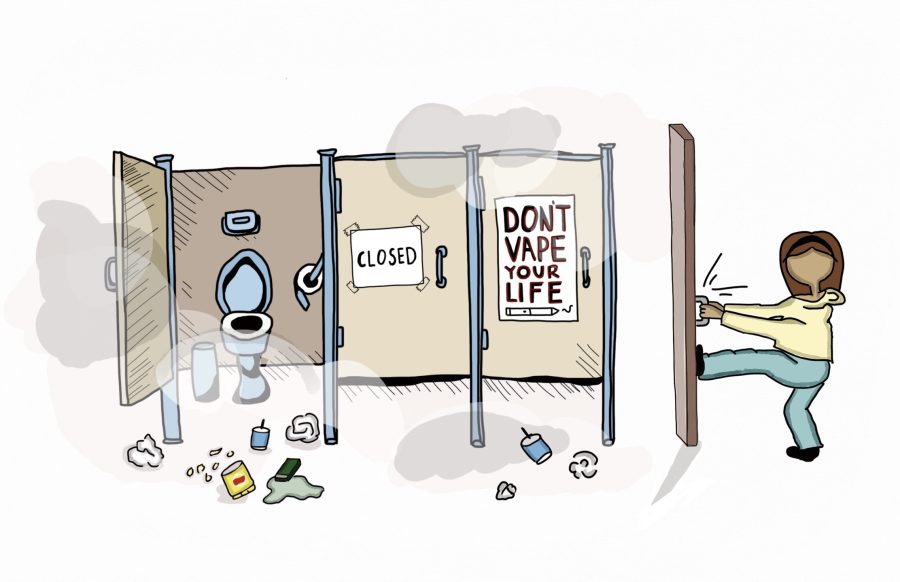EHS’s Bothersome Bathroom Burden
A student struggles to open a polluted and vandalized bathroom that is locked.
April 14, 2023
Asking students about their experience with the bathrooms at Edison High School is guaranteed to bring out disgust and groans. The pungent odor of vape, the sight of toilet paper strewn across the floor, and the shrieks of teenagers horsing around on toilet seats push students to find another restroom or avoid using one entirely. However, with restrictions surrounding the number of accessible bathrooms per period, students are limited to two options: Should they tolerate the unsanitary conditions and misbehavior of their classmates, or suppress their urges and endure discomfort in class?
Despite the administration restricting bathrooms to prevent loitering and vaping during class, many students attest to encountering unpleasant circumstances while using the facilities. Some admit to the bathrooms being “filthy and lacking supplies” while others complain, “there are always people hanging out and gossiping in the bathrooms. When I come in, they all stare at me, and it makes my bathroom experience uncomfortable”. While high school already represents the epitome of embarrassment and self consciousness, loitering cliques of teenagers serve to worsen this experience. Students lack privacy, often having to push past the crowd and ignore judgemental looks to use the sinks and toilets.
Locating an open bathroom is a stressful process, especially in the case of an emergency. Students typically make trips upstairs and downstairs to find an unlocked facility with hygienic conditions, but are inevitably forced to use the cafeteria bathrooms. Because they are one of the few that maintain availability, cafeteria bathrooms are filled with misbehaving teenagers, using the space to catch up with their friends while obstructing those trying to use the facility. Some utilize the restroom to eat their lunch, leaving leftover food scattered over the sink and opened ketchup packets smeared across the tiles. Besides contributing to the nauseating smell in the bathrooms, these adolescents show utter disrespect for students trying to use the space. Rather than treating the school restrooms as a public facility, several teenagers employ an entitled mindset, regarding the space as their personal playground. Without other options, students are expected to avert their gaze and limit time in the restroom. Some avoid the experience entirely and steer clear of the school facilities.
By refraining from bathroom trips during the school day, students are prone to health risks such as urinary tract infections and long-term kidney failure. Dr. Bandukwala, a urologist at Piedmont Healthcare, also suggests the possibility of “urinary incontinence or poor bladder emptying”. By leaving one bathroom open during a period, students have no choice but to go back to class when the stalls are preoccupied with loitering adolescents. Students are also neglected the option to use the restroom ten minutes after class starts and before class ends. They are typically asked to wait until ten minutes have passed, so the administration can prevent teenagers from loitering during passing, and so students listen to the most important parts of instruction. However, this rule forces students to ignore their bodies’ needs for a few moments of teachers’ directions and sacrifice their health because of their classmates’ misbehavior. Not only could the discomfort interfere with their attention in class, but they are likely to experience infections and detrimental conditions.
Access to facilities for girls is especially important, as they do not control when their menstrual cycle occurs. Girls need a sense of security, knowing there is a close, available bathroom in case of emergency. Changing sanitary products every three to four hours is a recommended practice for hygiene, if not a necessity, but the process of locating a bathroom twice during the school day is already a stressful endeavor. Some bathrooms containing sanitary product dispensers also remain locked during the day, making it difficult for female students to rely on the school’s provision of pads and tampons. Girls that cannot afford sanitary products, or simply forgot them, have to go to the nurse, and then find an open restroom, which means missing an ample amount of class time. Whereas young women could purchase sanitary products and change them in one restroom, keeping a limited number of facilities accessible extends the effort and is wasteful of school hours.
Despite the student body’s fixation on restrooms’ lack of accessibility, the administration demonstrated meaningful intentions behind closing the bathrooms. According to principal Mr. Charles Ross, students are given a Saturday detention the first time they are caught vaping, as well as “having conversations to try and give [the students] a redirection.” The second time the administration encounters a vaping student, they are required to have a conversation with the counselor. Rather than immediately punishing misbehaving students, Ross makes an effort to understand their motives and assist them in finding healthier habits. With limited security guards and a minimal budget, the administrators found closing restrooms to be the quickest solution to averting loitering, vaping teenagers.
But how much longer will this temporary solution last? There are no significant reported changes to support that limiting restrooms lessens the number of vaping students. In an attempt to inconvenience loitering students and cut down on e-cigarette use, the administration placed a burden on the rest of the student body simply looking to use the facilities.
However, rather than continuing to abide by present circumstances, Ross encourages students to be open about their problems, saying, “I appreciate students who complain that their needs aren’t being met.” While it may be simple to explain frustrations with restrooms to a classmate and forget about it later, connecting with the administration allows them to gain the student body’s perspective and form a compromise. Ross continued, adding that “any current ideas would be great since there’s a disconnect between the principal and the students.” With an inactive student body, the administration is less likely to recognize a problem with the current system and make amends.
Nevertheless, it is important to acknowledge that disheveled bathrooms and disobedient teenagers are prevalent among high schools across New Jersey, if not the country. Many might argue that this is the plague of the supposed irresponsible Generation Z. In previous years, several TikTok trends regarding vandalizing bathroom property went viral, encouraging students to clog urinals and damage sinks to gain the approval of their peers. Chasing after views, teenagers made the hashtag “#deviouslick” gain popularity quickly, in which students would post items they stole from their school facilities as “entertainment.” As a result, countless administrations feel forced to make decisions that sacrifice their students’ freedom to protect the bathroom environment. Teenagers need to be mindful of their actions and weigh the consequences. Is temporary validation on social media worth year-round restroom restrictions for the entire student body?
Maintaining the availability of school bathrooms also means addressing the root of the issue: underage drug use. Whether it is a matter of conformity or the adrenaline rush following a rebellious action, schools have to deter teenagers from the substance, and ingrain the harmful effects of vaping in the student body early-on. Students should also take accountability, and vilify the culture surrounding use of e-cigarette products. Many adolescents post videos smoking or drinking on the internet, hoping to gain traction. Unfollowing the accounts and avoiding interaction with the posts discourages substance users, and steers them away from resorting to drug use for attention. Rather than painting vaping as rebellious and compelling, teenagers need to focus on long-term health consequences and the disruptions in academic environments. Similarly, students need to be mindful of eagerly following new social media trends. Seemingly harmful pranks might cause distress and inconvenience to others, so it is important to analyze the situation before acting. However, students should remember to be supportive and assist their friends in talking to reliable adults and asking for help in cases of addiction. Learning about symptoms surrounding drug addiction will help distinguish struggling classmates and could expedite the recovery process.
Ultimately, the restoration of school bathroom availability falls upon both the student body and the administration, as a combination of guidance from trusted adults and friends is the most effective way to discourage substance use among teenagers.

























































































